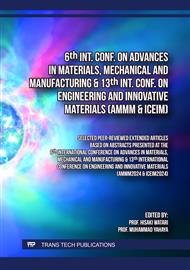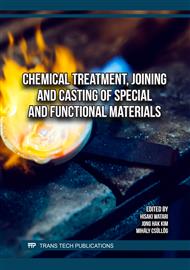p.45
p.57
p.77
p.83
p.89
p.95
p.105
p.117
p.123
Thermodynamic Stability and Density Functional Theory Simulations of Gold Complexes in Ethaline DES Leaching of Refractory Ores at Varied Temperatures
Abstract:
Extraction of metallic gold from refractory ores is traditionally energy-intensive and most often damaging to the environment. Ethaline DES offers an alternative to dissolve gold using an environmentally benign yet chemically stable process. The study aims to explore the efficiency and mechanisms of gold dissolution of refractory ores using Ethaline DES in a room and at elevated temperatures by investigating the thermodynamic stability of the system. Results from the leaching experiments showed that gold dissolution was significantly higher at an elevated temperature (50°C) compared to room temperature (25°C) in Ethaline DES. It is further confirmed with thermochemical data that the entropy and heat capacity of the system were enhanced at an elevated temperature. Maximum gold dissolution was observed at 56.74% during the 48th hour of the leaching process at elevated temperatures. Meanwhile, leaching at room temperature only yielded 18.56% of gold during the 6th hour but precipitated for the rest of the leaching period. Density functional theory (DFT) simulation and thermodynamic calculations showed that AuCl2[C2H4O2]2-was the most stable complex. With the lowest Gibbs free energy and highest HOMO-LUMO gap, exhibiting superior stability and lower reactivity than the others. This study supports the use of Ethaline DES as a sustainable method for refractory gold extraction, highlighting the critical role of temperature in optimizing its efficiency.
Info:
Periodical:
Pages:
117-122
Citation:
Online since:
June 2025
Price:
Сopyright:
© 2025 Trans Tech Publications Ltd. All Rights Reserved
Share:
Citation:



